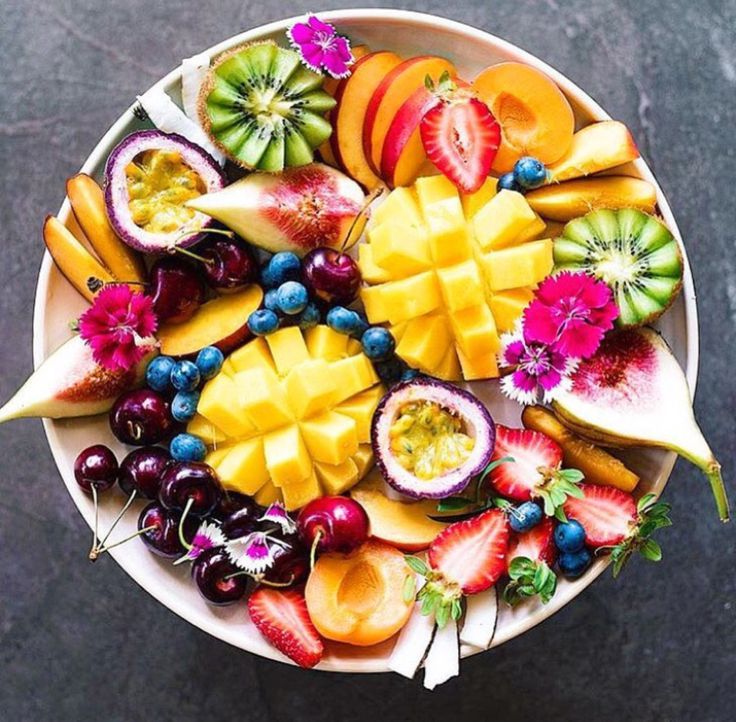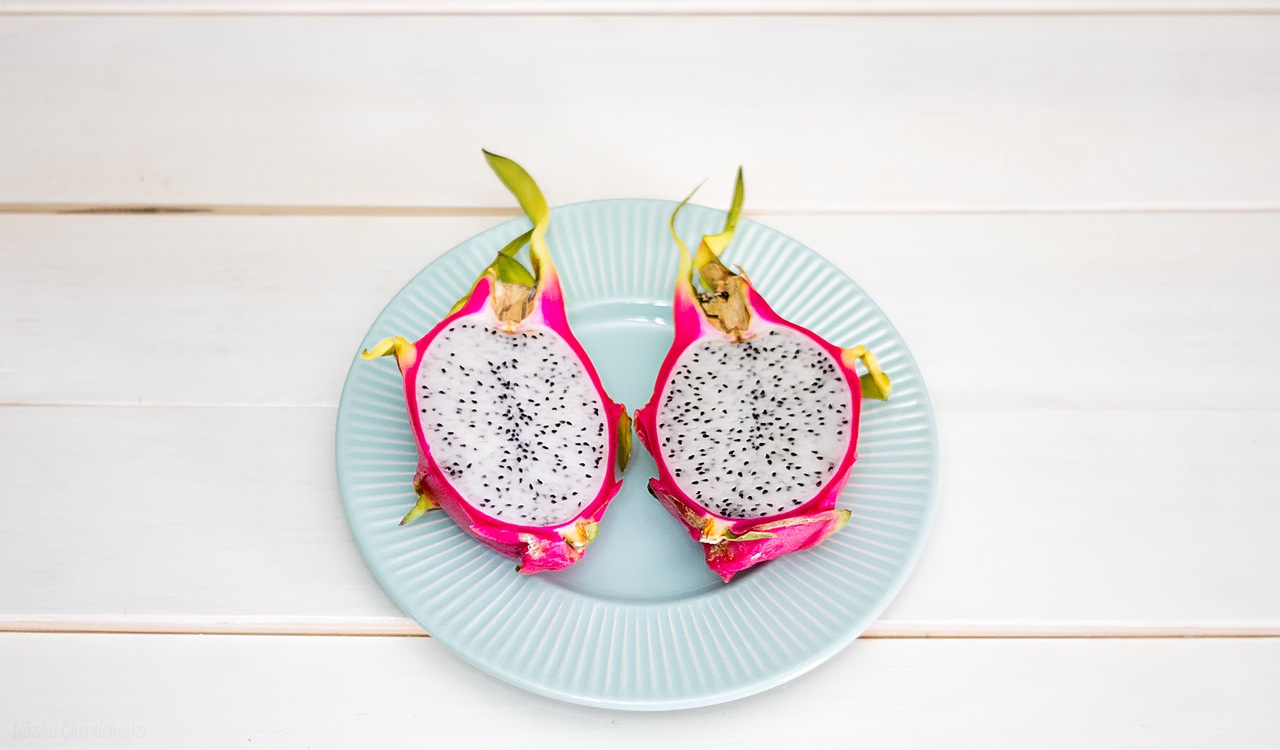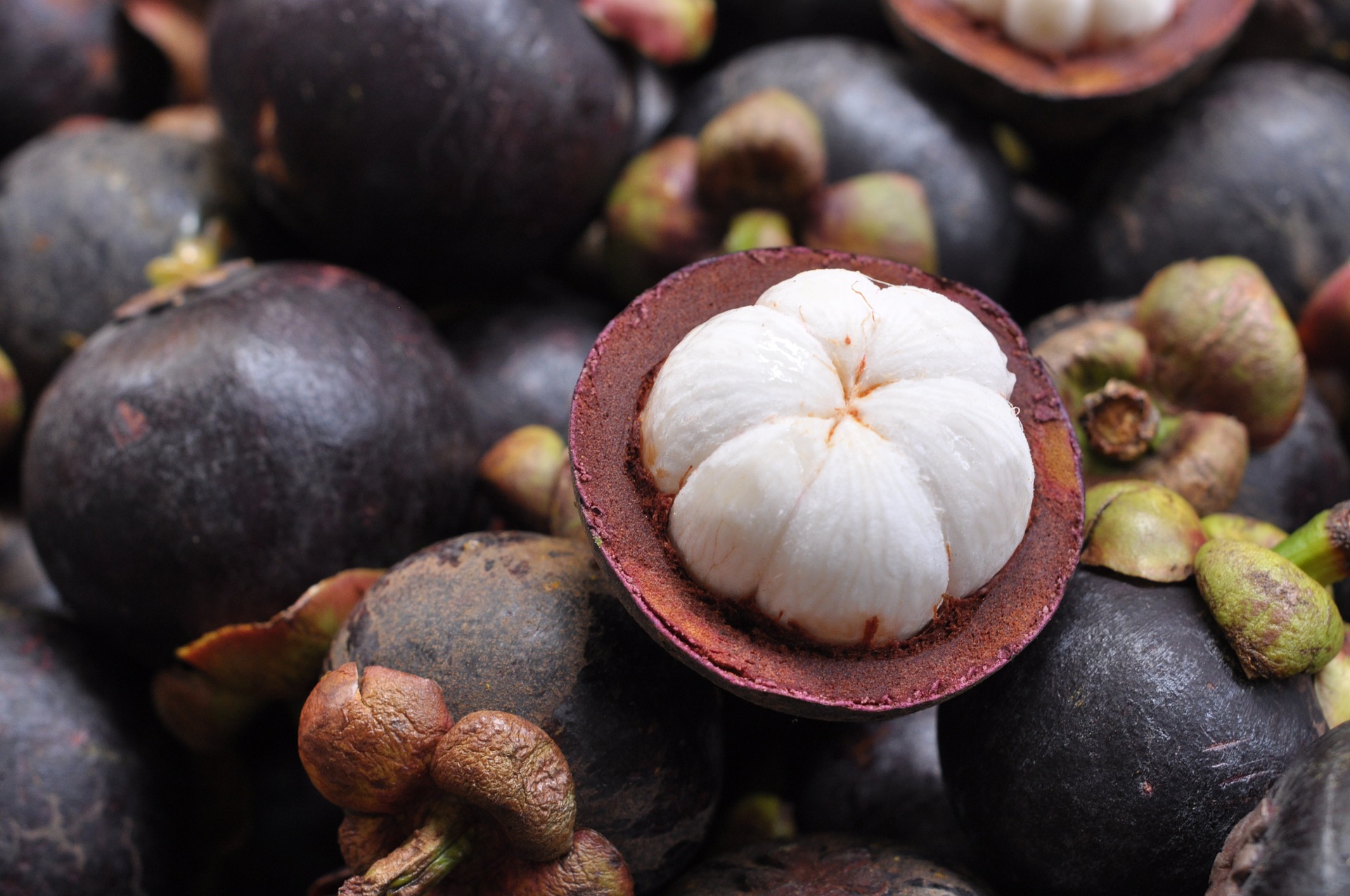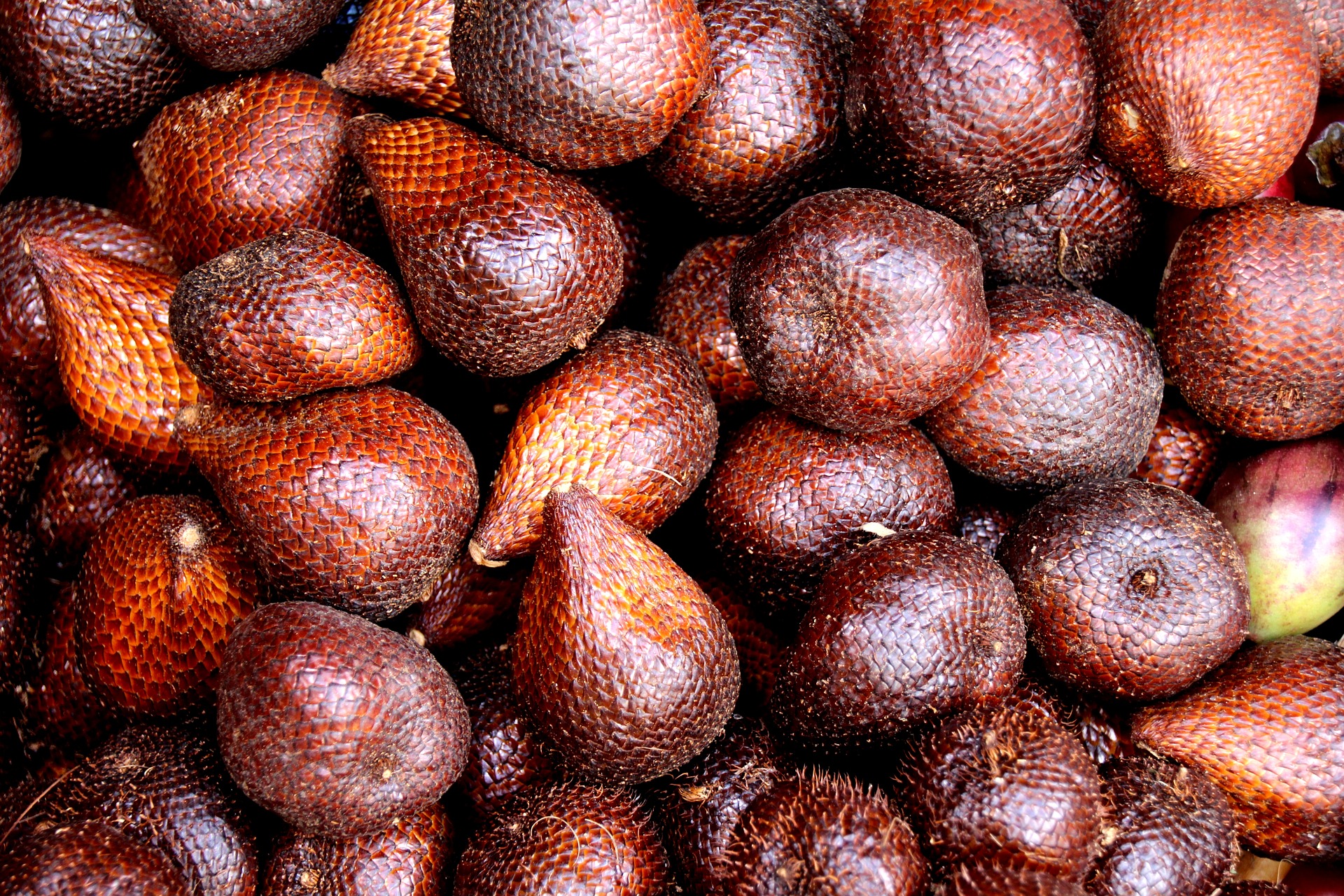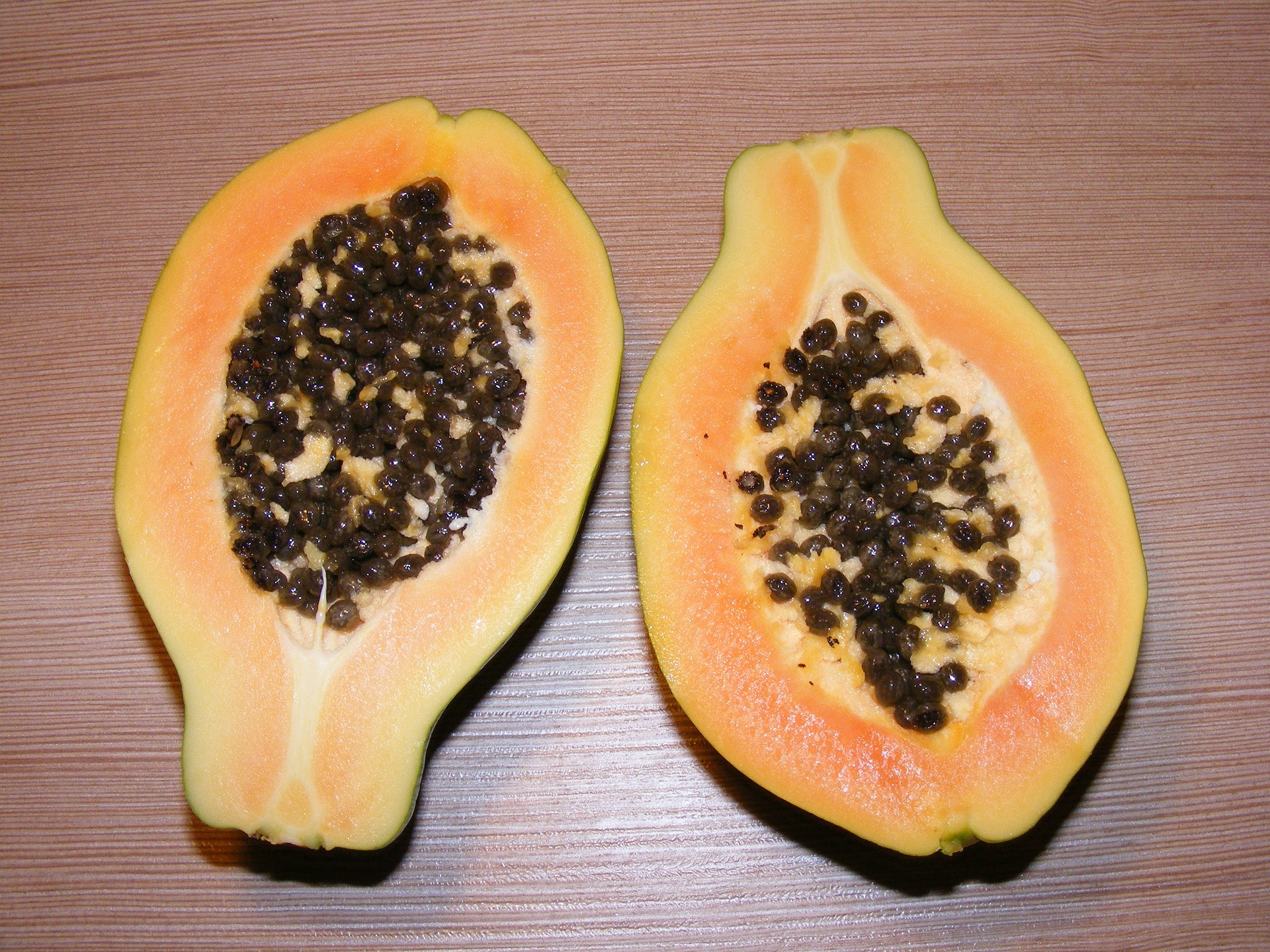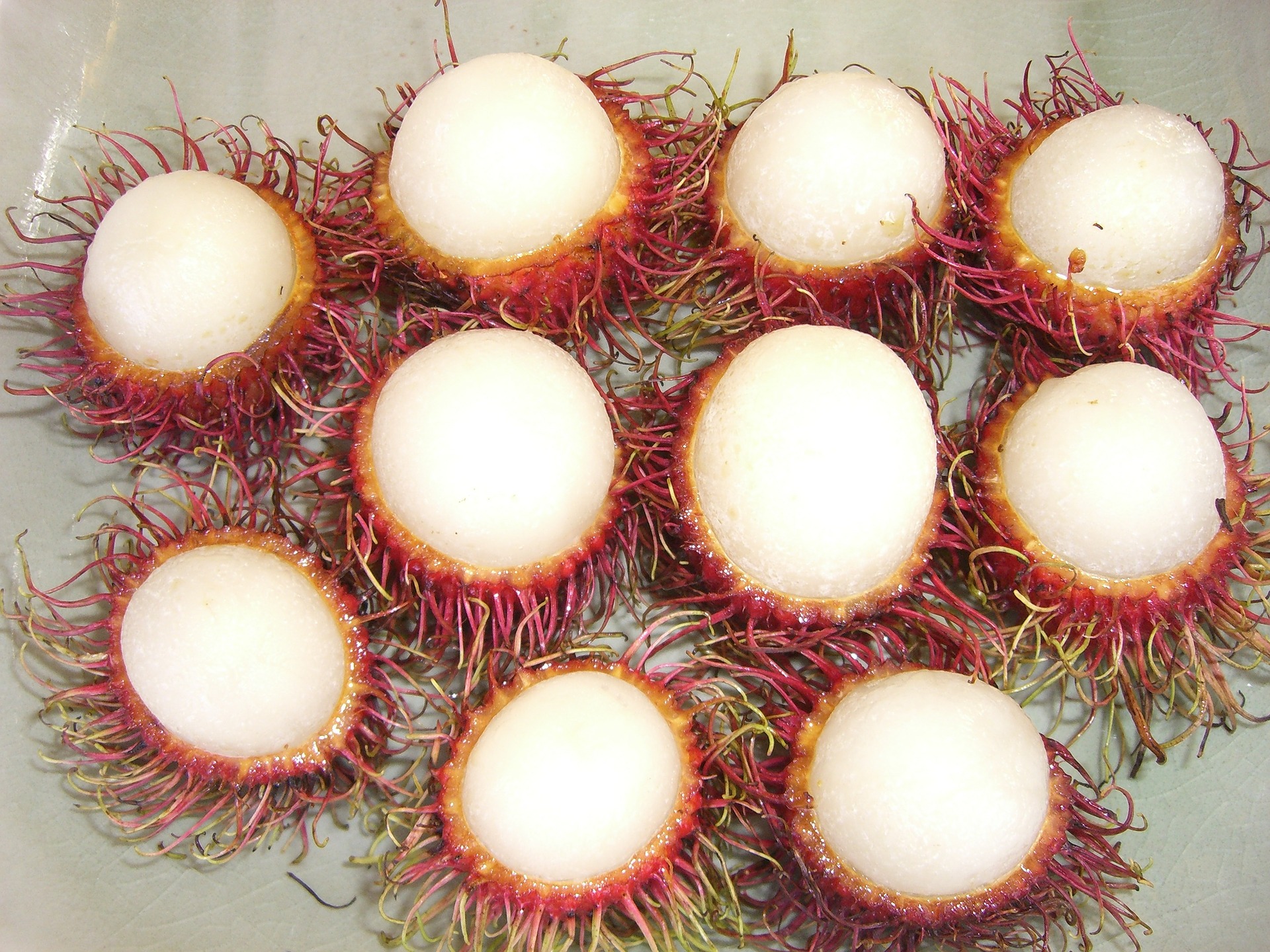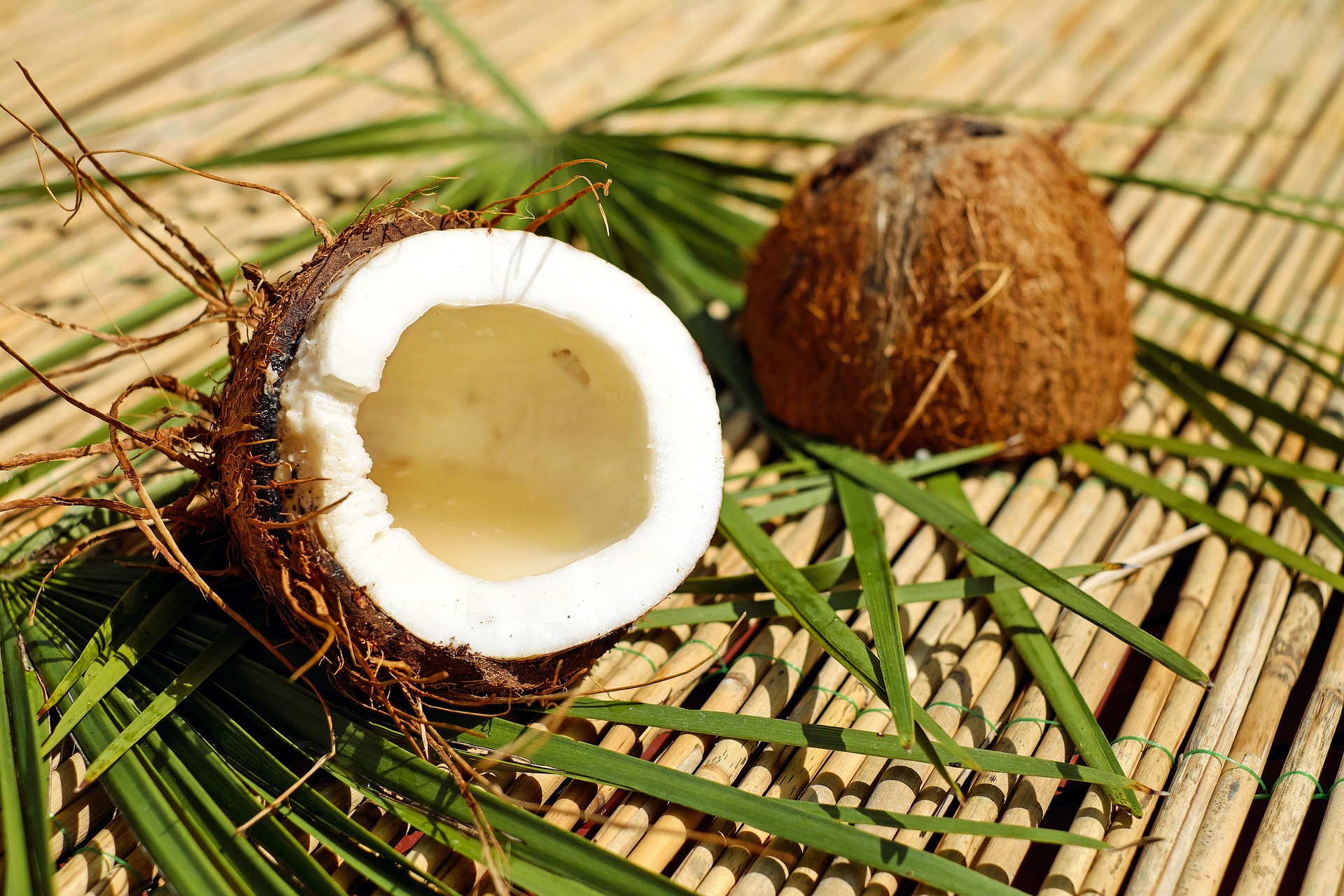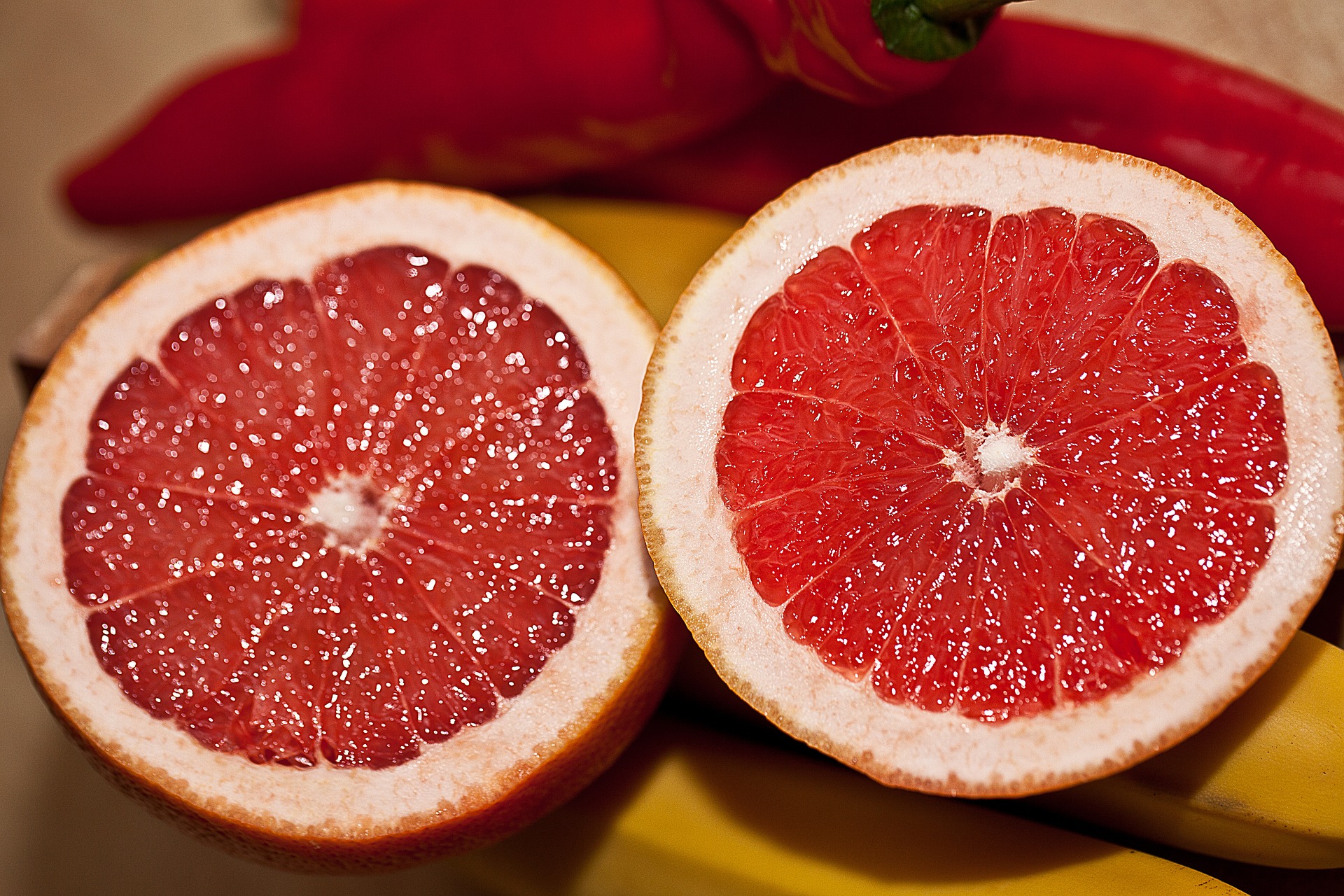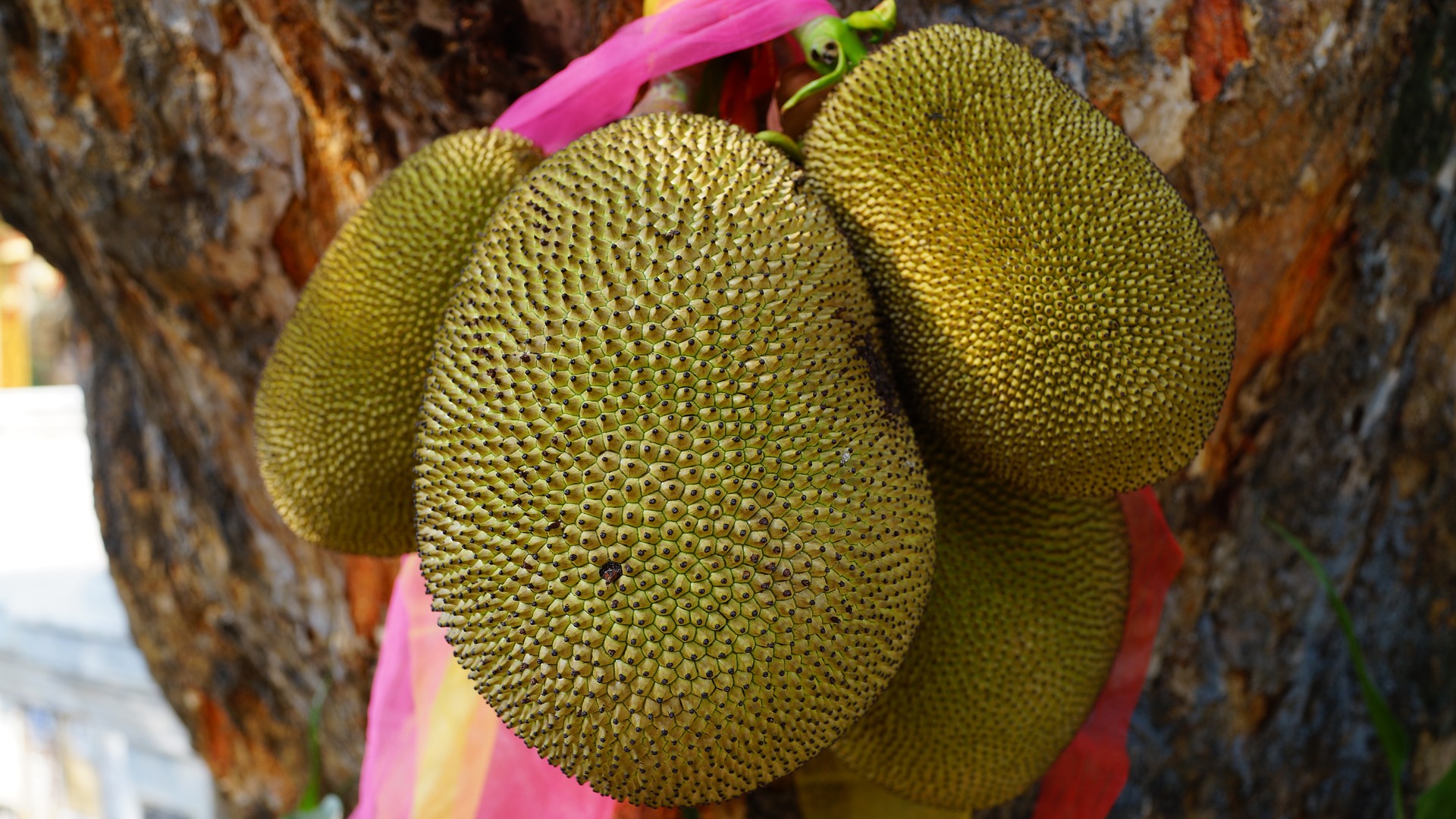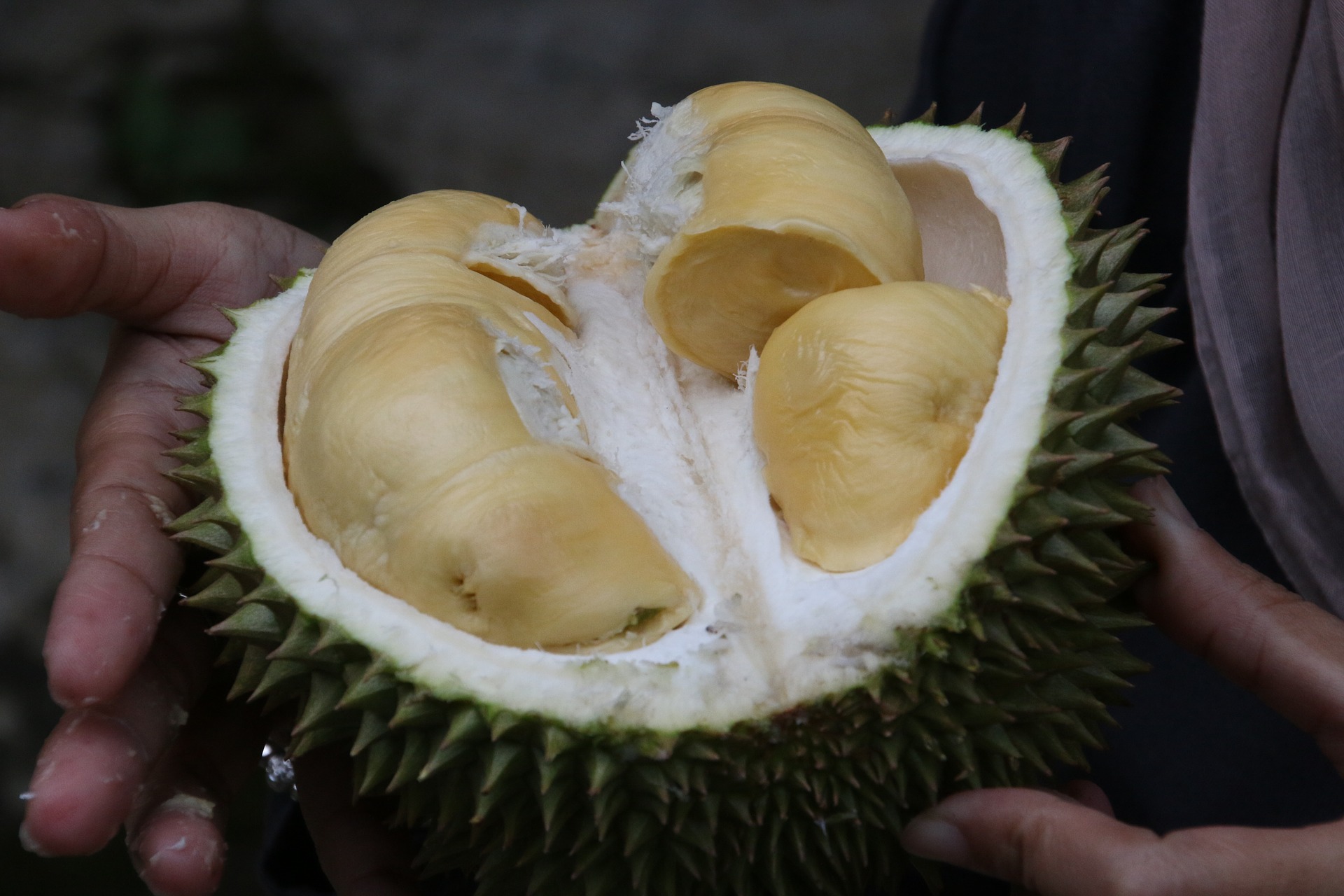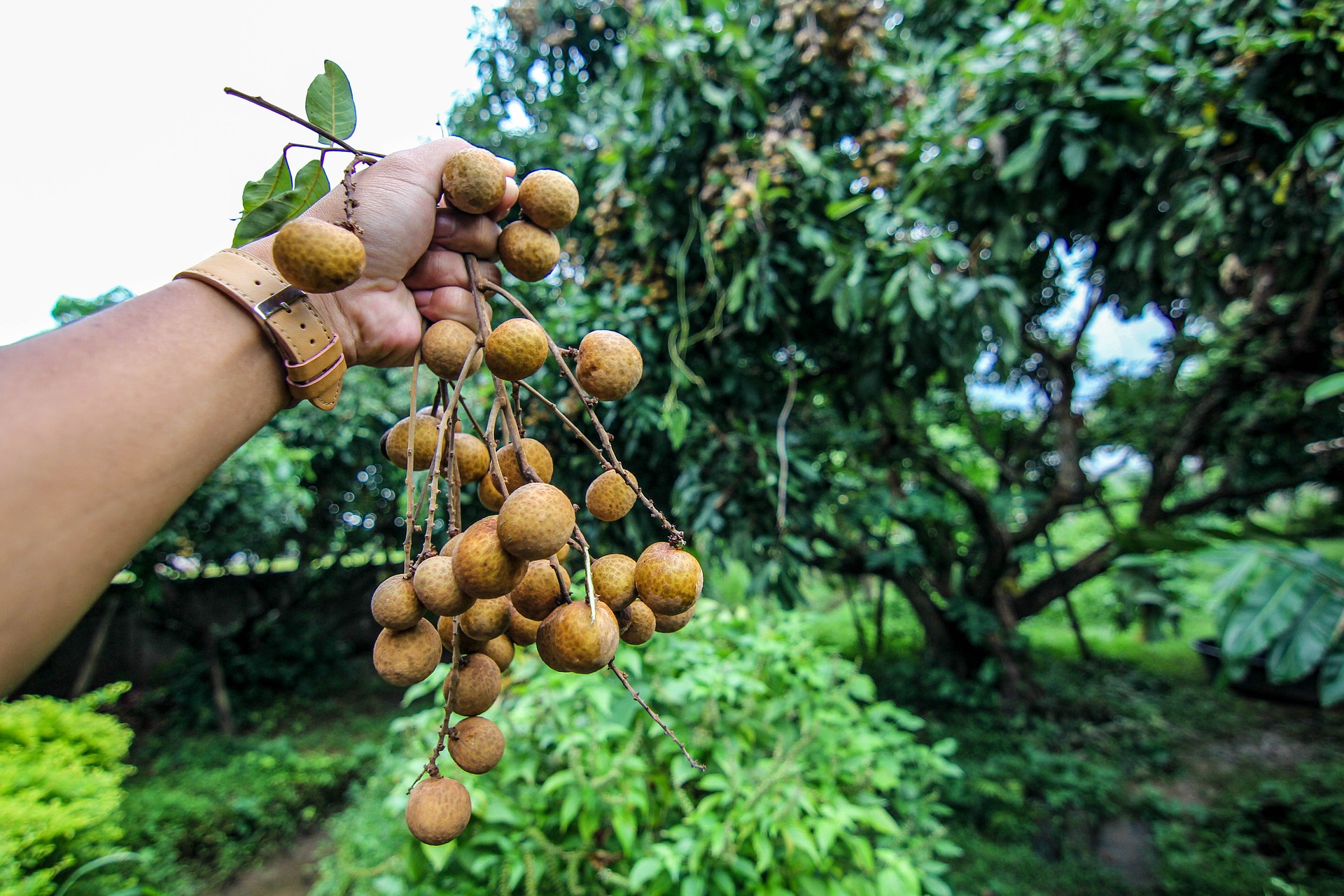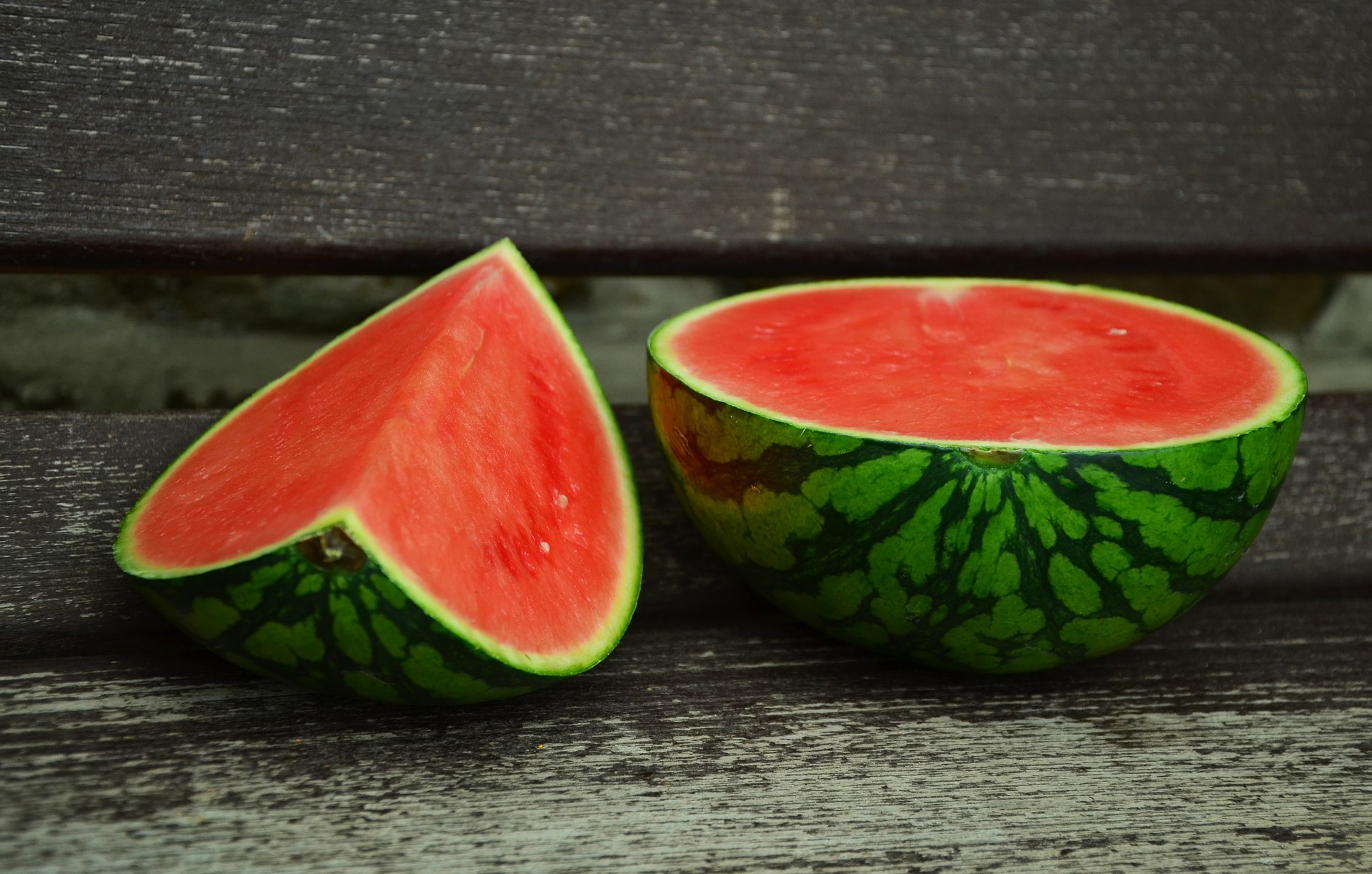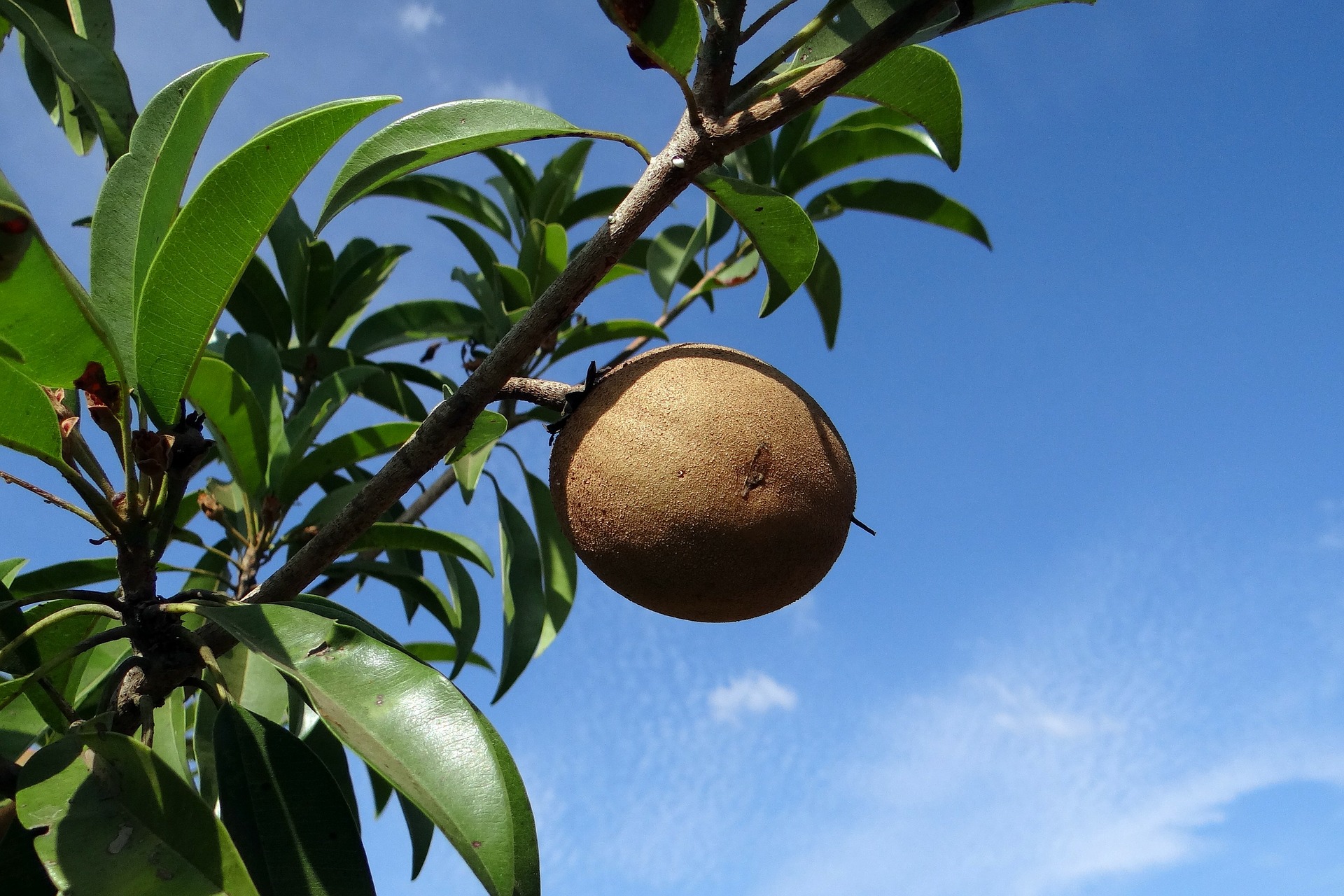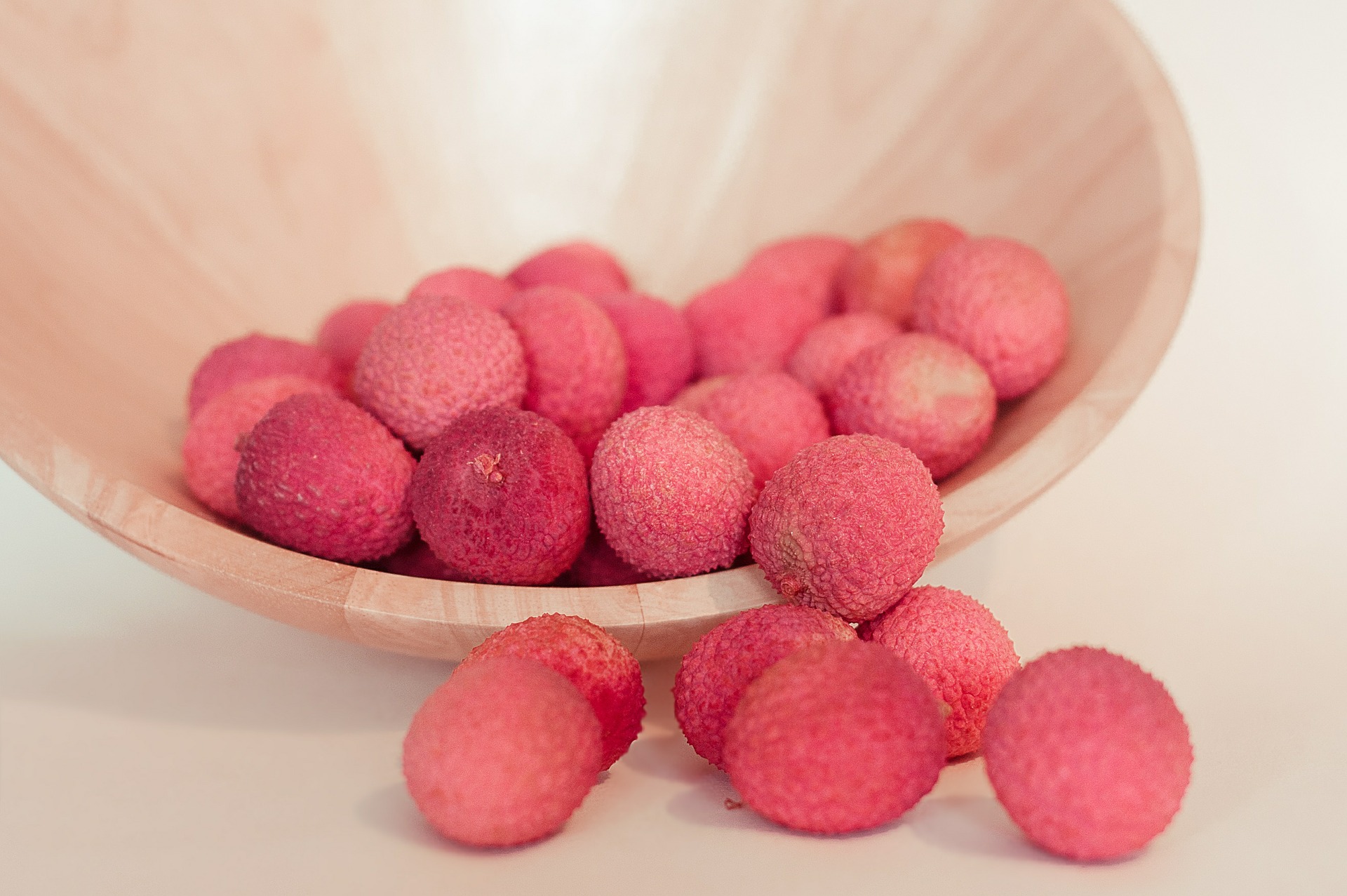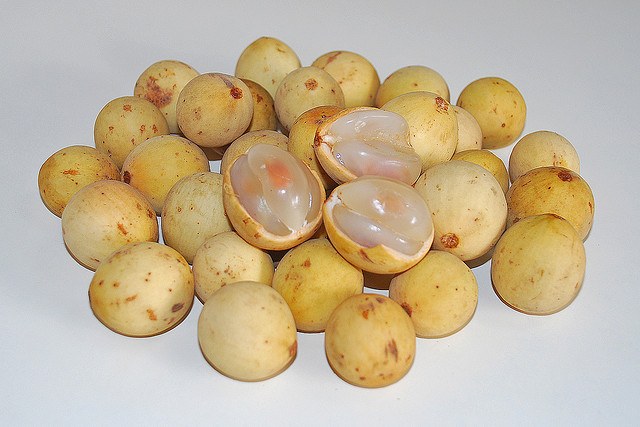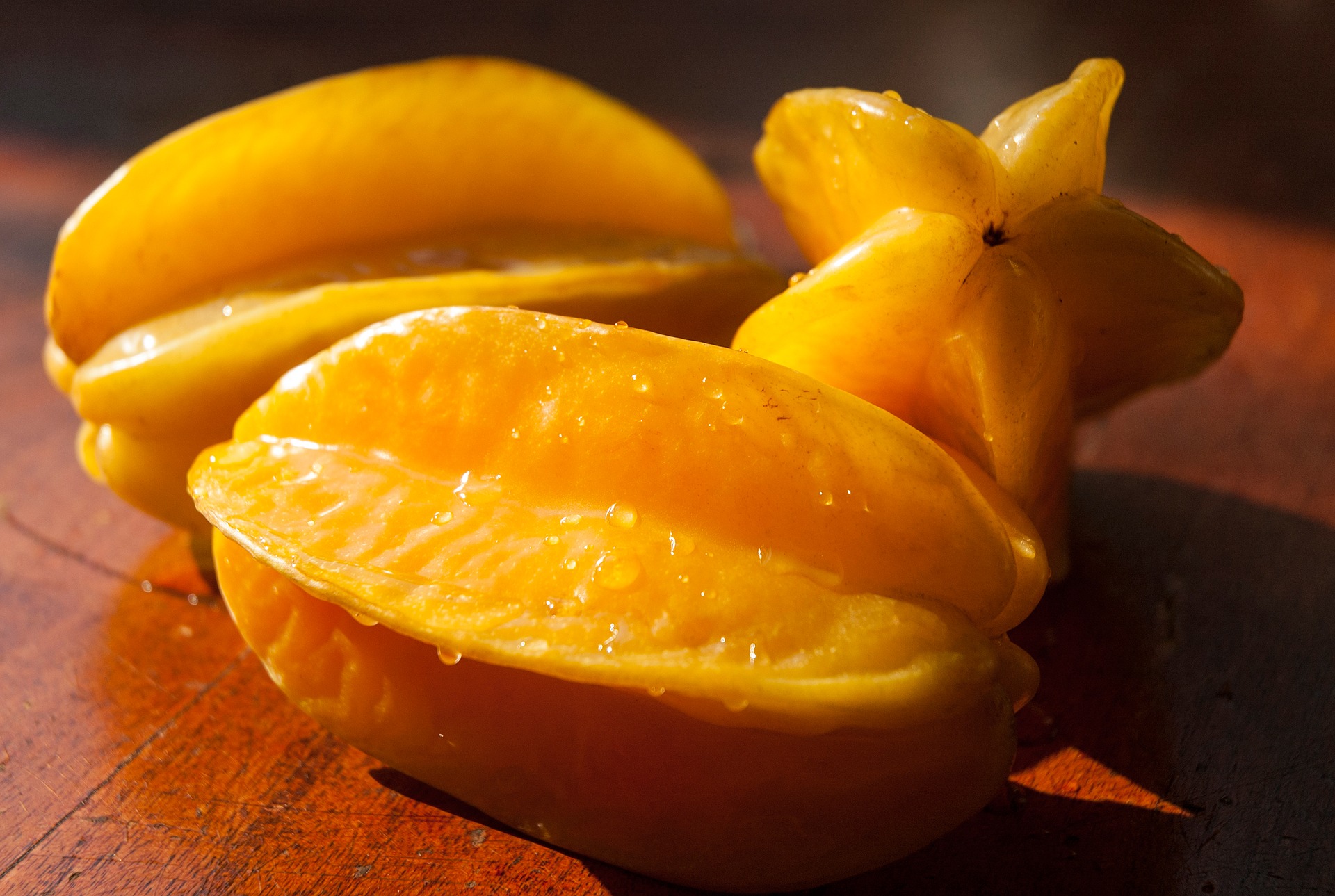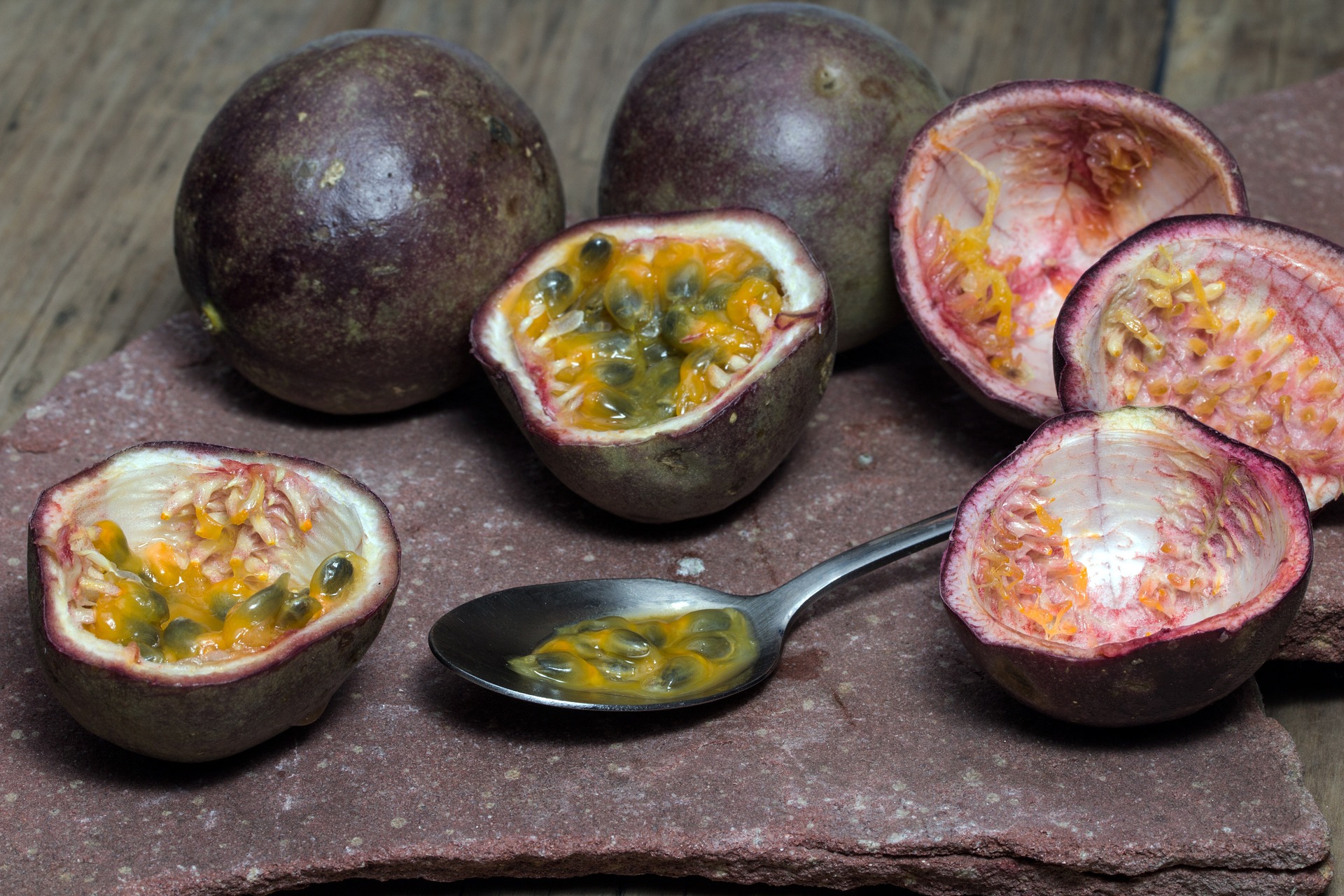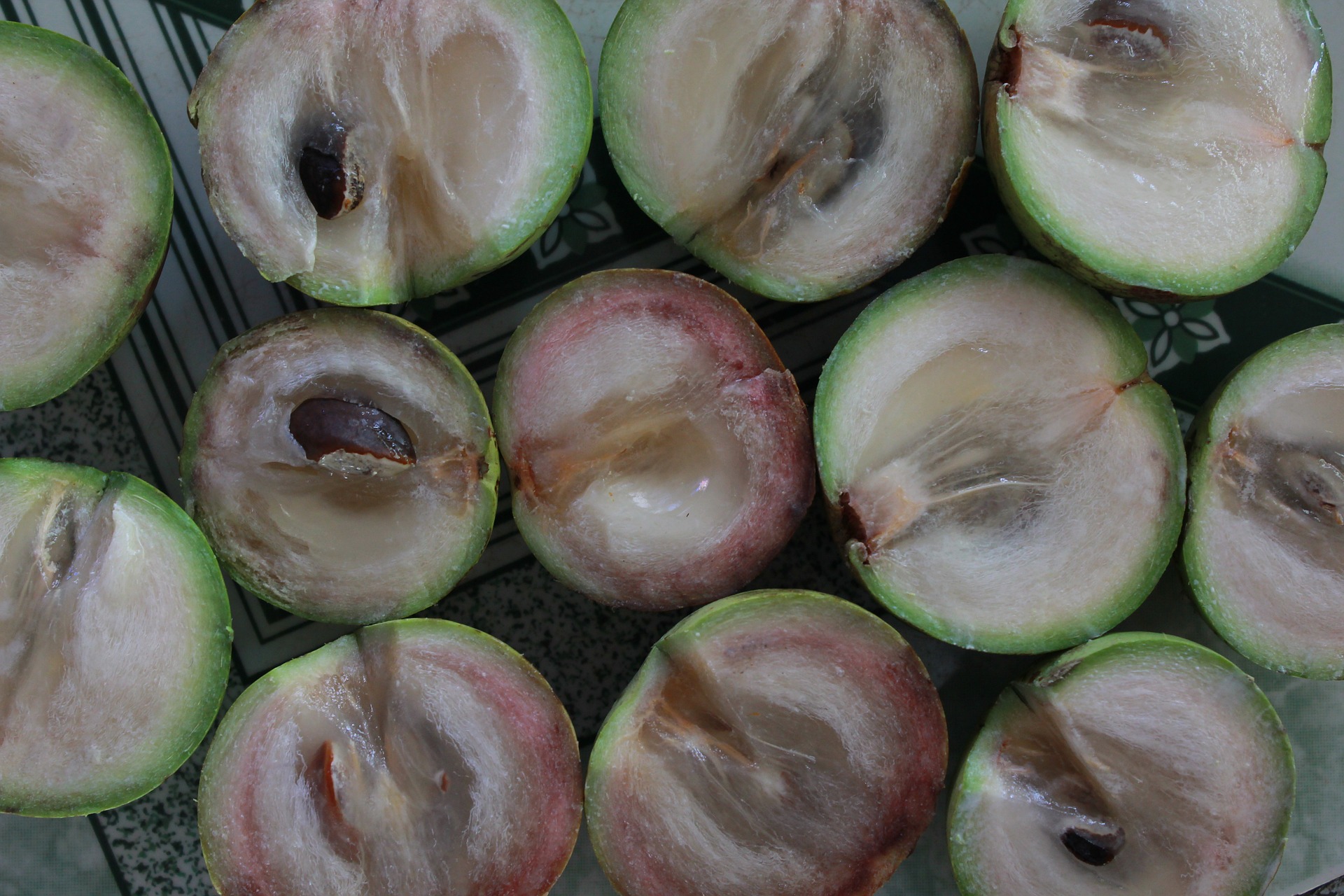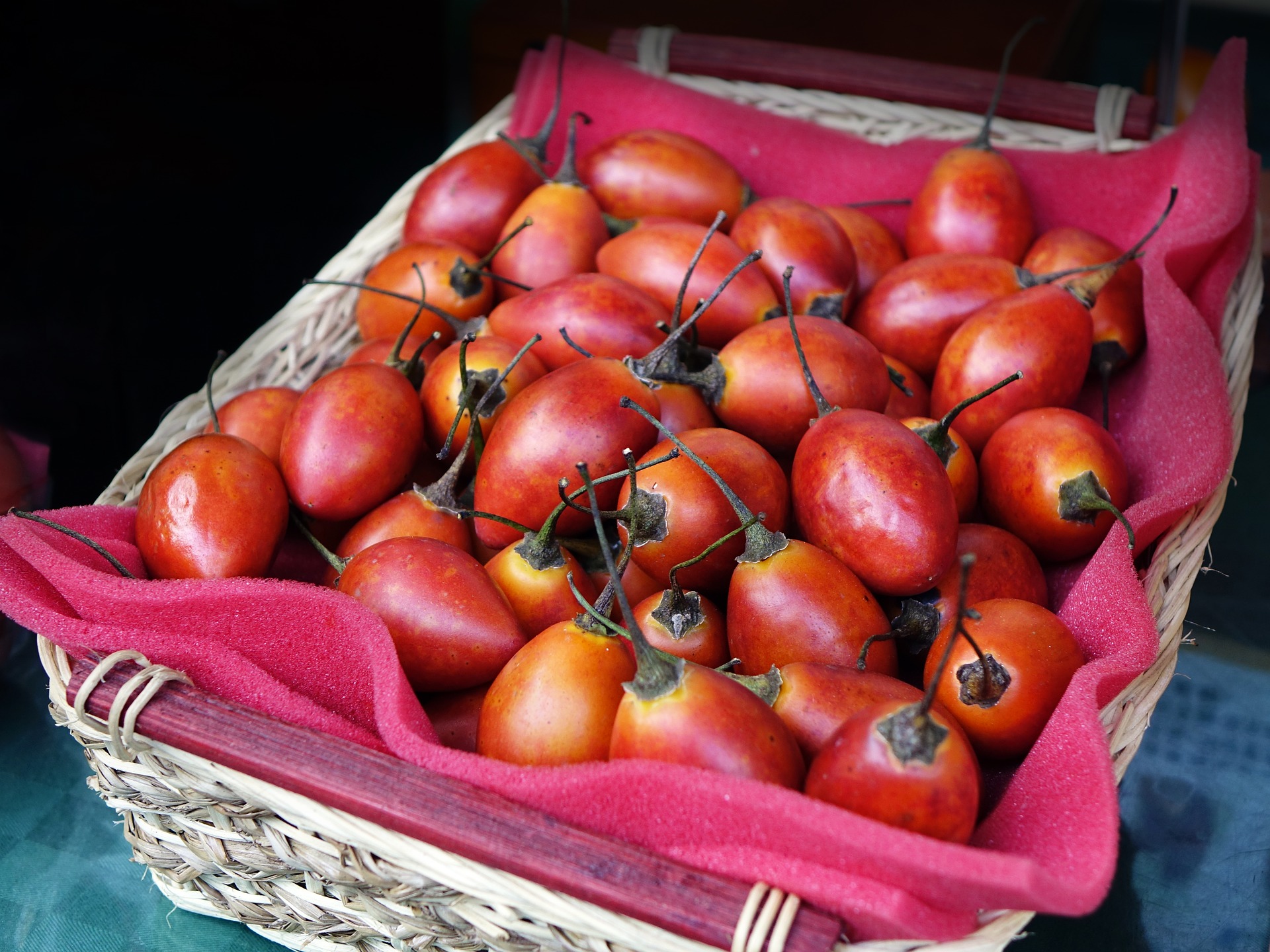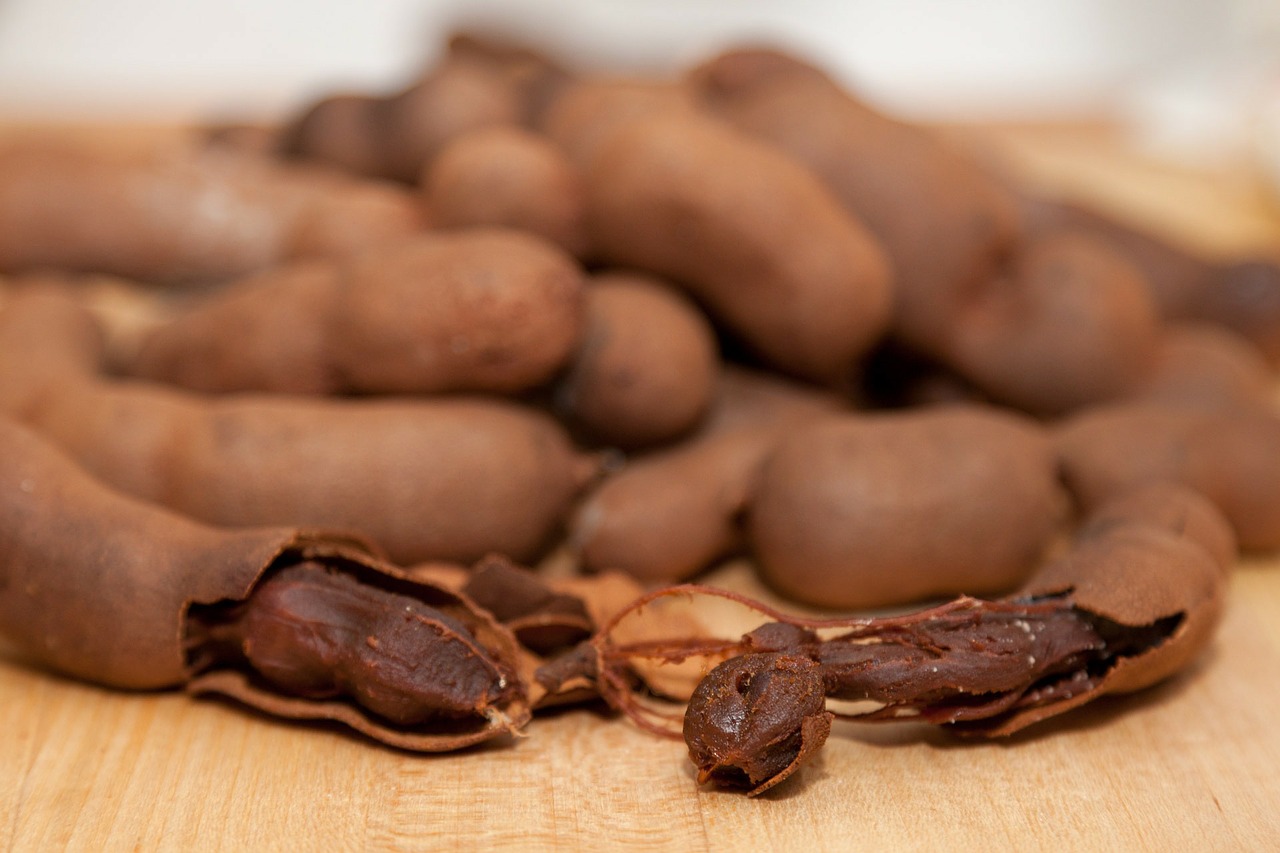South East Asia is blessed with a vast variety of exotic fruits. You can see here dragon fruit, rambutan, pomelo, mango, mangosteen, durian, jackfruit, guava and many other delicious and unique fruits. When bought in a season they can be ridiculously cheap. Here is our guide to the most popular South East Asian fruits.
Are you ready to discover them?
Dragonfruit or Pitaya
The dragonfruit is pink and green with a leafy skin. It grows on cactus-like trees and blooms only at night. This fruit has a white or red (depending on variety) flesh, and a delicate, slightly perceptible aroma. The mild taste of pitaya (or dragonfruit) flesh is often remarked upon, as it stands in stark contrast to the vibrant exterior. The taste can be described as very bland… like a melon or kiwifruit, with a “mild sweetness.” In its fresh form, dragon fruit can be eaten on its own or added to salads and smoothies.
Mangosteen
Mangosteen is a huge (from 6 to 25 meters) evergreen tree which grows mainly in Southeast Asia, Southwest India and other tropical areas such as Puerto Rico and Florida. The fruit of the mangosteen is sweet and tangy, juicy, somewhat fibrous, with fluid-filled vesicles (like the flesh of citrus fruits), and has an inedible, deep reddish-purple colored rind. In each fruit, the fragrant edible flesh that surrounds each seed is botanically endocarp. Seeds are almond-shaped and sized.
Mango
Mango is one of the most popular, nutritionally rich tropical fruits with unique flavor, fragrance, and taste. Among the many tropical fruits mango, remains one of our favorite. It seems you can eat it as much as you want and never get tired. The fruit varies in size and color and is available in many varieties. The young green version is bitter and sour and used for salads, while the ripe mango is yellow and can be eaten raw.
Snake Fruit or Salak
Salak is a species of palm tree native to Java and Sumatra in Indonesia. The fruits grow in clusters at the base of the palm and are also known as snake fruit due to the reddish-brown scaly skin. They are about the size and shape of a ripe fig, with a sharp tip. The pulp is edible. This fruit can be peeled by pinching the tip, which should cause the skin to slough off so it can be pulled away. The fruit inside consists of three lobes with the two larger ones, or even all three, containing a large inedible seed. The lobes resemble and have the consistency of, large peeled garlic cloves. The taste is usually sweet and acidic, with a strong astringent edge, but its apple-like texture can vary from dry and crumbly to moist and crunchy. Usually eaten fresh, the snakefruit can also be pickled or candied in syrup.
Papaya
The papaya is a large, tree-like plant, with a single stem growing from 5 to 10 m tall, with spirally arranged leaves confined to the top of the trunk. The fruit is a type of berry. It is ripe when it feels soft (as soft as a ripe avocado or a bit softer) and its skin has attained an amber to orange hue. Papaya fruit has sweet, red or orange flesh with many small round and black seeds inside. The ripe fruit of the papaya is usually eaten raw, without skin or seeds. In fact, the smell of ripe, fresh papaya flesh can strike some people as unpleasant. The unripe green fruit can be eaten cooked, usually in curries, salads, and stews.
Rambutan
The rambutan is a medium-sized tropical tree. The name also refers to the edible fruit produced by this tree. The rambutan is native to the Malay-Indonesian region, and other regions of tropical Southeast Asia. It is closely related to several other edible tropical fruits including the lychee, longan, and mamoncillo. The name ‘rambutan’ is derived from the Malay-Indonesian language’s word for rambut or “hair,” a reference to the numerous hairy protuberances of the fruit. This fruit is a round to oval single-seeded berry, 3–6 cm (rarely to 8 cm) long and 3–4 cm broad, borne in a loose pendant cluster of 10–20 together. The leathery skin is reddish (rarely orange or yellow), and covered with fleshy pliable spines, hence the name, which means ‘hairs.’ The fruit flesh is translucent, whitish or very pale pink, with a sweet, mildly acidic flavor very reminiscent of grapes.
Coconut
Coconuts grow on palm trees. They are known for their great versatility, as evidenced by many traditional uses, ranging from food to cosmetics. Coconuts are distinct from other fruits for their large quantity of “water,” and when immature, they are known as tender-nuts or jelly-nuts and may be harvested for their potable coconut water. As development continues, cellular layers of endosperm deposit along the walls of the coconut, becoming the edible coconut “flesh.” Usually, a young coconut is served with a small hole in the top. You can drink the water with a straw. After that, you can cut the rest of the coconut in halves and eat the flesh.
Pomelo
Pomelo is a natural (non-hybrid) citrus fruit, with the appearance of a big grapefruit, native to South and Southeast Asia. It is usually pale green to yellow when ripe, with sweet white (or, more rarely, pink or red) flesh. The fruit tastes like a sweet, mild grapefruit though the typical pomelo is much larger than the grapefruit.
Jackfruit
Jackfruit is the largest tree-borne fruit in the world, reaching as much as 35 kg in weight, 90 cm in length, and 50 cm in diameter. The skin of this fruit is green and hard. Usually, the jackfruit is cut in half, and the 5 centimeter long yellow and soft pieces can be taken out. The fruit has a distinctive sweet and fruity aroma. A fully ripe and unopened jackfruit is known to “emit a strong aroma,” with the inside of the fruit described as smelling of pineapple and banana.
Guava
Guavas are common tropical fruits cultivated and enjoyed in many tropical and subtropical regions. Guava fruits are round or oval depending on the species. They have a pronounced and typical fragrance, similar to lemon rind but less sharp. The outer skin may be rough, often with a bitter taste, or soft and sweet. Varying between species, the skin can be any thickness, is usually green before maturity, but becomes yellow, maroon, or green when ripe. The pulp inside may be sweet or sour and off-white (“white” guavas) to deep pink (“red” guavas). The seeds in the central pulp vary in number and hardness, depending on species. In many countries, guava is eaten raw, typically cut into quarters or eaten like an apple, whereas in other countries it is eaten with a pinch of salt and pepper, cayenne powder or a mix of spices (masala). Guava juice is popular in many countries. The fruit is also often prepared in fruit salads.
Durian
Regarded by many people in southeast Asia as the “king of fruits,” the durian is distinctive for its large size, strong odor, and formidable thorn-covered husk. Durians are big and can weigh up to three kilos. Its shape ranges from oblong to round, the color of its husk green to brown, and its flesh pale-yellow to red, depending on the species. Some people regard the durian as having a pleasantly sweet fragrance; others find the aroma overpowering with an unpleasant odor. The smell evokes reactions from deep appreciation to intense disgust and has been described variously as rotten onions, turpentine, and raw sewage. The persistence of its odor, which may linger for several days, has led to the fruit’s banishment from certain hotels and public transportation in Southeast Asia.
Longan
Longan is commonly associated with lychee, which is similar in structure but more aromatic in taste. “Longan” means “Dragon’s eyes” in Chinese. It is so named because it resembles an eyeball when its fruit is shelled. The seed is small, round and hard, and of an enamel-like, lacquered black. The fully ripened, freshly harvested fruit has a bark-like shell, thin, and firm, making the fruit easy to peel by squeezing the pulp out as if one is “cracking” a sunflower seed. Longan is sweet, juicy and succulent in superior agricultural varieties. The seed and the shell are not consumed. Apart from being eaten fresh and raw, longan fruit is also often used in Asian soups, snacks, desserts, and sweet-and-sour foods, either fresh or dried and sometimes preserved and canned in syrup.
Watermelon
Watermelons are one of the most famous fruits in Southeast Asia. The fruit has a smooth hard rind—usually green with dark green stripes or yellow spots—and a sweet, juicy interior flesh—usually deep red to pink, but sometimes orange, yellow, or white—with many seeds, which can be soft and white or hard and black. The fruit can be eaten raw, pickled or the rind cooked.
Meyer Lemon
Meyer lemon is a citrus fruit native to China thought to be a cross between a true lemon and either a mandarin or common orange. The Meyer lemon fruit is yellow and rounder than a true lemon. The skin is fragrant and thin, colored a deep yellow with a slight orange tint when ripe. Meyer lemon fruits have a sweeter, less acidic flavor than supermarket lemon varieties.
Sapodilla
Sapodilla is grown in large quantities in India, Thailand, Malaysia, Cambodia, Indonesia, Bangladesh, and Mexico. It looks a bit like a mix of kiwifruits and potatoes and tastes similar to the pear. A fully ripened fruit has saggy skin and does not release chicle when picked. Each fruit contains one to six seeds that are hard, glossy, and black, resembling beans, with a hook at one end. You can cut sapodilla in halves, take the seeds out and eat the flesh with a spoon.
Lychee
Lychee is a tropical fruit tree native to southern China and now cultivated in many parts of the world. The outside of the fruit is covered by a pink-red, roughly-textured rind that is inedible but easily removed to expose a layer of sweet, translucent white flesh. The fresh fruit has a delicate, whitish pulp with a floral smell and a fragrant, sweet flavor. Since this perfume-like flavor is lost in the process of canning, lychee is usually eaten fresh or added to desserts and served with ice cream.
Langsat
The fruit of a species of tree belonging to the Mahogany family, the langsat is oval, round or elliptical in shape. The fruits look much like small potatoes and are borne in clusters similar to grapes. Langsat contains 1 to 3 seeds, flat, and bitter tasting; the seeds are covered with a thick, clear-white aril that tastes sweet and sour. The taste has been likened to a combination of grape and grapefruit and is considered excellent by most. The sweet juicy flesh contains sucrose, fructose, and glucose. Langsats are eaten raw or bottled as syrups.
Goji Berry
Goji Berry (or wolfberry) is the fruit of a shrub native to China. This fruit is bright orange-red, ellipsoid berry 1–2 cm in diameter. The number of seeds in each berry varies widely based on cultivar and fruit size, containing 10–60 tiny yellow seeds that are compressed with a curved embryo. The berries ripen from July to October. As food, dried wolfberries are traditionally cooked before consumption and often added to rice congee and almond jelly, as well as used in Chinese tonic soups.
Kumquat
Kumquats are a group of small fruit-bearing trees in the flowering plant family Rutaceae, native to Southeast Asia and the Asia-Pacific region. The edible fruit closely resembles that of the orange, but it is much smaller, being approximately the size and shape of a large olive. The peel has a sweet flavor, but the fruit has a sour center. The fruit can be eaten cooked but is mainly used to make marmalades and jellies.
Starfruit or Carambola
The star fruit, also known as carambola, is the fruit of a species of trees native to South Asia. The fruit has distinctive ridges running down its sides (usually five but can sometimes vary); in cross-section, it resembles a star, hence its name. The skin is thin, smooth, and waxy and turns a light to dark yellow when ripe. Ripe carambolas are sweet without being overwhelming as they rarely have more than 4% sugar content. The taste is difficult to compare, but it has been likened to a mix of apple, pear, grape, and citrus fruits. Unripe starfruits are firmer and sour and taste like green apples. They may also be used in cooking and can be made into relishes, preserves, and juice drinks.
Maracuja or Passionfruit
It is cultivated commercially in tropical and subtropical areas for its sweet, seedy fruit. The passion fruit is a pepo, a type of berry, round or oval, either yellow or dark purple at maturity, with a soft to firm, juicy interior filled with numerous seeds. The fruit is both eaten and juiced. Maracuja juice is often added to other fruit juices to enhance the aroma.
Soursop or Sirsak

Soursop is the fruit of Annona muricata, a broadleaf, flowering, evergreen tree. The fruits are dark green and prickly with aromatic, juicy flesh. The taste of the fruit can be described as a combination of strawberry and pineapple, with sour citrus notes contrasting with an underlying creamy flavor reminiscent of coconut or banana. Soursop is widely promoted as an alternative cancer treatment.
Star Apple
The fruit is round and typically measures from 2 to 3 inches in diameter. When ripe, it usually purple-skinned with a faint green area appearing around the calyx. A radiating star pattern is visible in the pulp. The skin is rich in latex, and both it and the rind are not edible. Star apples are delicious as a fresh dessert fruit; it is sweet and best served chilled. Infusions of the leaves have been used against diabetes and articular rheumatism. The fruit also exists in three colors, dark purple, greenish brown and yellow. The purple fruit has a denser skin and texture while the greenish brown fruit has a thin skin and a more liquid pulp; the yellow variety is less common and difficult to find.
Tamarillo
Tamarillo is a wonderful egg-shaped fruit. Its color varies from yellow and orange to red and almost purple. Sometimes tamarillo has dark, longitudinal stripes. Red fruits are more acetous, yellow and orange fruits are sweeter. The flesh has a firm texture and contains many large seeds. This fruit is very high in vitamins and iron and low in calories.
Tamarind
The tamarind tree produces edible, pod-like fruit which is used extensively in cuisines around the world. The fruit has a fleshy and juicy pulp. It is mature when the flesh is colored brown or reddish brown. The tamarinds of Asia have longer pods containing 6 to 12 seeds. The seeds are somewhat flattened and glossy brown. The tamarind is best described as sweet and sour in taste and is high in tartaric acid, sugar, B vitamins and calcium.

